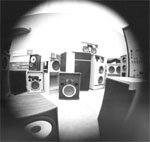For what use? I would think that depends on the size of the room.
That said, given that the discussion was impliedly about mains (AVR v. separates) and not about subs, it's worth noting that different rules apply when deep bass is involved. Speakers get less efficient, so they need more voltage drive.

Originally Posted by
brett_s 
I was expecting more thoughts or debate on this. Not quite as many as in the "high cost wire and cord" thread, but at least a couple more

.
There's one point to which all reasonable and knowledgable people analyzing the data in good faith must agree, for if they don't they are either unreasonable or analyzing the data in bad faith (often with said bad faith analysis driven by pecuniary interests):
To date, with levels matched and preconceived biases removed from the equation, nobody has yet been able to reliably distinguish a difference between two non-broken audio electronics chains of sufficient bandwidth and gain, assuming enough power to adequately drive the loudspeakers to the intended SPL.





 Reply With Quote
Reply With Quote
 .
.
 long post, but the standard measurements that are significantly different? Significant difference from a purely scientific point of reference... I'm not so sure.
long post, but the standard measurements that are significantly different? Significant difference from a purely scientific point of reference... I'm not so sure. )
)
 )
) right now. Most of us have been around long enough and worked these issues often enough that we know these things already, so just be quiet about them. I didn't just make this stuff up today. Lordy, I've got quite a few different rooms, different audio chains, and different source materials in my own house to have quite a lot of practical experience, and plenty of folks (some from this forum) have been over for testing, calibration, listening, critiquing, placement assistance, you name it, so it's not like available science wasn't applied. These same things are true of the acquaintances I visit in some of the audio and video groups I hang out with. We have endless, interesting, and mostly productive discussions about how to optimize everyone's gear, including swapping out amps, treating rooms, changing components, and using different source material.
right now. Most of us have been around long enough and worked these issues often enough that we know these things already, so just be quiet about them. I didn't just make this stuff up today. Lordy, I've got quite a few different rooms, different audio chains, and different source materials in my own house to have quite a lot of practical experience, and plenty of folks (some from this forum) have been over for testing, calibration, listening, critiquing, placement assistance, you name it, so it's not like available science wasn't applied. These same things are true of the acquaintances I visit in some of the audio and video groups I hang out with. We have endless, interesting, and mostly productive discussions about how to optimize everyone's gear, including swapping out amps, treating rooms, changing components, and using different source material.






